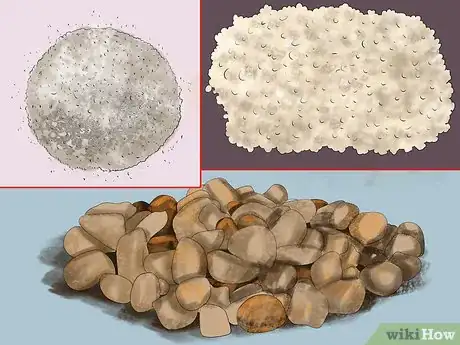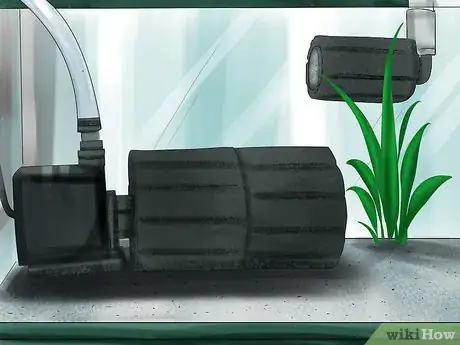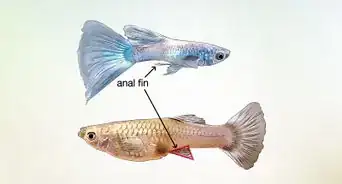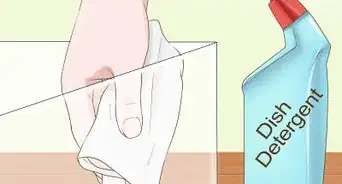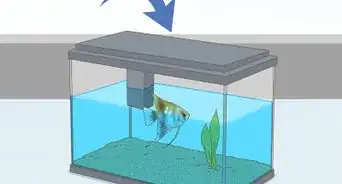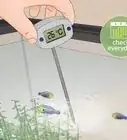This article was co-authored by Pippa Elliott, MRCVS. Dr. Elliott, BVMS, MRCVS is a veterinarian with over 30 years of experience in veterinary surgery and companion animal practice. She graduated from the University of Glasgow in 1987 with a degree in veterinary medicine and surgery. She has worked at the same animal clinic in her hometown for over 20 years.
This article has been viewed 64,278 times.
Peacock Eels are beautiful freshwater fish with large spots on their sides that resemble the markings one might find on a peacock. They tend to grow to be ten to fifteen inches and can be great tank companions for similarly sized fish of equal aggressive tendencies.[1] Caring for your peacock eel takes a bit more effort than some other fish, but can be extremely rewarding.
Steps
Setting Up Your Tank
-
1Choose a fish tank. Peacock eels need a decent amount of space in their tank to swim and for vegetation. They need a fairly large tank in order to thrive, so you may need to consider how many eels you want before choosing a tank.
-
2Add substrate to the tank. Peacock eels are borrowers that spend much of their time buried in the substrate at the bottom of your tank, so make sure to give them plenty of material to burrow in.
- Use aquarium gravel or freshwater aquarium sand purchased from a pet store to make sure it is clean and parasite free.
- If you use gravel, peacock eels prefer fine gravel for their burrowing.[4]
- Add approximately four inches of substrate to the bottom of the tank to create the best possible environment for your peacock eels.
Advertisement -
3Fill the tank with water. Peacock eels are sensitive fresh water fish that require specific water quality. Taking care to ensure you have the water treated properly will go far in helping your peacock eels adapt to their new environments and remain healthy. [5]
- Use water conditioner that removes chlorine and chloramine from the water in the tank.
- Peacock eels are known as “brackish” fresh water eels, which means they are freshwater fish that prefer some salt content in their water. You should add up to one teaspoon of aquarium salt per gallon of water in the tank to keep your peacock eels happy and healthy.
-
4Place your filter. There are a few different options for water filters that are well suited for keeping peacock eels. If you are using a larger tank, placing the pump below the substrate may be a good option, otherwise you may want to use a filter that attaches to the side of your tank. [6]
- A canister filter under the substrate can do a good job of keeping the oxygen content of the water higher, but can be an issue for your borrowing eels.
- Filters that affix to the side of the tank and have outflow right at the surface of the water are usually safer for this breed of fish.
- Choose a filter that provides a water turnover of ten to fifteen times per hour.
-
5Adorn your tank with decorations and vegetation. Peacock eels are more active in dimly lit aquariums so adding vegetation can make them more comfortable and give you more opportunities to see them in action.
- Floating plants are great for peacock eels.
- Aquarium safe caves and castles are good for peacock eels to play and hide in.
- Driftwood roots and potted plants are also great for them to hide in and around.[7]
Caring for Your Peacock Eel
-
1Keep the water clean. Although the water filter in the tank will help keep the tank clean, peacock eels can be very sensitive to water quality. Peacock eels may require more water maintenance that some other breeds of tropical fish. [8]
- Replace approximately 30% of the water in the tank each week.
- Peacock eels prefer very clear and clean water, so if your water become foggy change it out and consider adjusting your filtration method.
-
2Start by feeding your peacock eels every day. Once you are sure your peacock eels are healthy and adjusting to your aquarium you can reduce feeding to multiple times per week, but feed them frequently until then. [9]
- Peacock eels need live food to survive. Bloodworms, black worms and tubifex are excellent food sources and can be bought at most pet stores.
- The worms you feed your peacock eel can burrow into the substrate and establish their own colonies so your eel will have plenty to eat.
- Over time, peacock eels can even learn to eat right from your hand!
-
3Keep the water the right temperature. Peacock eels don't usually require tank heaters to adjust the temperatures of the water. Many people who live in warmer climates will find their tanks don't require any kind of heater.
- Peacock eels prefer temperatures above 72 degrees Fahrenheit, so if your house stays warmer than that on average you probably won't need a tank heater.
- Never let the water in your tank exceed 80 degrees.
-
4Be patient. Peacock eels tend to become very shy when introduced to new environments. They will hide most of the time when first brought into a new home, but with the right variables in place they can become happy members of your aquarium's community.[10]
- Over time, peacock eels can become extremely friendly fish.
- If you set your tank up to make the peacock eels feel safe, they will begin emerging from their hiding places sooner.
Choosing Tank Mates
-
1Decide on whether or not you want other fish. Peacock eels can be good community fish, but sharing the tank can cause some complications in your care of the peacock eels and their companions.
- Make sure any fish you choose prefer similar water temperatures and conditions to that of the peacock eel. Peacock eels can be more sensitive to changes in their environments than some other fish.
- Peacock eels will eat smaller fish, so it's best to keep them with fish that are larger than they are.[11]
-
2Pick the right kinds of tank mates. Peacock eels can be aggressive toward smaller fish but don't do well among fish that are much more aggressive than they are. They can be great tank mates provided they share their home with the right kinds of fish. [12]
- Peacock eels get along well with other fish of the same breed as long as they are of similar size.
- Peacock eels can get along well with peaceful fish, but you should monitor their interactions to ensure your peacock eels don't hurt the less aggressive fish.
- Peacock eels and their tank mates are safest when they are all “semi-aggressive” fish.
- Examples of fish that are safe with peacock eels are swordtails, rainbow fish, and ottocinclus cats.
-
3Make sure your peacock eels eat. Peacock eels are easily bullied away from food by faster or more aggressive fish. You may need to take special precautions to ensure your peacock eels don't end up going hungry as a result of their tank mates.[13]
- Try feeding your peacock eels in the evening when other fish are less active.
- Make sure to watch your peacock eels eat to ensure their food isn't taken by more aggressive fish.
References
- ↑ http://www.tropical-fish-keeping.com/peacock-eel-macrognathus-siamensis.html#sthash.hFabon6W.dpbs
- ↑ http://www.tropical-fish-keeping.com/peacock-eel-macrognathus-siamensis.html#sthash.hFabon6W.dpbs
- ↑ http://www.petsmart.com/live-pet/live-fish/peacock-eel-zid36-15162/cat-36-catid-700002
- ↑ http://www.petsmart.com/live-pet/live-fish/peacock-eel-zid36-15162/cat-36-catid-700002
- ↑ http://animal-world.com/encyclo/fresh/Eels/PeacockEel.php
- ↑ http://www.tropical-fish-keeping.com/peacock-eel-macrognathus-siamensis.html#sthash.hFabon6W.dpbs
- ↑ http://www.tropical-fish-keeping.com/peacock-eel-macrognathus-siamensis.html#sthash.hFabon6W.dpbs
- ↑ http://www.tropical-fish-keeping.com/peacock-eel-macrognathus-siamensis.html#sthash.hFabon6W.dpbs
- ↑ http://animal-world.com/encyclo/fresh/Eels/PeacockEel.php
About This Article
To keep peacock eels, get a tank that holds at least 35 gallons of water, and line the bottom of it with 4 inches of fine gravel or sand so your eels have room to burrow. To feed your peacock eels, give them live food, like bloodworms and tubifex, multiple times per week. If you want to keep your eels with other fish, choose fish that are a similar size since peacock eels will eat smaller fish. For more tips from our Veterinary co-author, like how to maintain the right water temperature for your peacock eels, read on!

